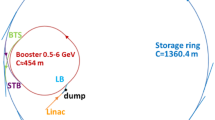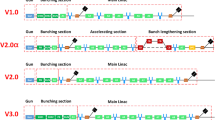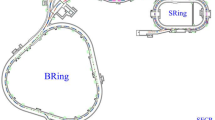Abstract
Purpose
The High Energy Photon Source (HEPS) is a 6 GeV diffraction-limited storage ring light source being built in China. HEPS booster ramps the beam energy from 500 MeV to 6 GeV with a repetition rate of 1 Hz. For the beam dynamics simulations, the consideration of the fringe field effects is not ignorable.
Method
To this end, several methods based on one-dimensional and three-dimensional magnetic fields are used to model the dipoles and quadrupoles of booster.
Results and conclusion
In this paper, we evaluate the impacts of magnetic fringe field effects of dipoles and quadrupoles on the optics of the HEPS booster.





Similar content being viewed by others
References
Y. Jiao, G. Xu, X. Cui et al., The HEPS project. J. Synchrotron Radiat. 25, 1611–1618 (2018)
C. Meng, X. He, Y. Jiao et al., Physics design of the HEPS LINAC. Radiat. Detect. Technol. Methods 4, 497–506 (2020)
Y. Peng, Z. Duan, Y. Guo et al., Design of the HEPS booster lattice. Radiat. Detect. Technol. Methods 4, 425–432 (2020)
Y. Guo, Y. Wei, Y. Peng et al., The transfer line design for the HEPS project. Radiat. Detection Technology and Methods 4, 440–447 (2020)
Yi. Jiao, F. Chen, P. He et al., Modification and optimization of the storage ring lattice of the high energy photon source. Radiat. Detect. Technol. Methods 4, 415–424 (2020)
Lin Wang et al., The Nonlinear Effects of Fringe Fields In HLS, in Proceedings. PAC07, TUPMN059, Albuquerque, USA
M. Streichert, V. A. Rodriguez, A. Bernhard, et al., Simulations of fringe fields and multipoles for The ANKA storage ring bending magnets. In: Proceedings. IPAC’12, TUPPP011, New Orleans, USA, 2012
J. Choi, Y. Hidaka, W. Guimei, et al., Dipole Fringe Field Analysis of the NSLS-II Storage Ring. in Proceedings. IPAC’18, TUPMK014, Vancouver, Canada, 2018
M. Borland, R.R. Lindberg, Modeling of Dipole and Quadrupole Fringe-Field Effects for The Advanced Photon Source Upgrade Lattice”, in Proceedings. NAPAC2016, THPOA13, Chicago, USA
M. Berz et al., Fringe field effects in small rings of large acceptance. Phys. Rev. ST Accel. Beams 3, 124001 (2000)
Private communication with HEPS magnet system
A. Terebilo, Accelerator toolbox for MATLAB. In Talk presented at (No. SLAC-PUB-8732), 2001.
M. Borland, “elegant: A Flexible SDDS-Compliant Code for Accelerator Simulation,” Advanced Photon Source LS-287, September 2000.
Karl L. Brown. A first and Second-order Matrix Theory for the Design of Beam Transport Systems and Charged Particle Spectrometers. SLAC 75, Revision 3, SLAC,1972
M. Venturini, A. Dragt, Accurate computation of transfer maps from magnetic field data. NIM A 427, 387–392 (1999)
High Energy Accelerator Research Organization (KEK). https://acc-physics.kek.jp/SAD/. Accessed 13 May 2020
D. Zhou et al., Explicit maps for the fringe field of a quadrupole, Proc. IPAC10
J. Irwin et al., Explicit soft fringe maps of a quadrupole, Proc. PAC95
Acknowledgements
The authors would like to thank their colleagues in the HEPS accelerator physics system for the fruitful suggestions and comments. This work is supported by High Energy Photon Source (HEPS), a major national science and technology infrastructure, National Natural Science Foundation of China (No. 11922512,12275284), Youth Innovation Promotion Association of Chinese Academy of Sciences (No. Y201904), and Key Laboratory of Particle Acceleration Physics and Technology, CAS (No. JSQ2021ZZ01).
Author information
Authors and Affiliations
Corresponding author
Ethics declarations
Conflict of interest
On behalf of all authors, the corresponding author states that there is no conflict of interest.
Rights and permissions
Springer Nature or its licensor (e.g. a society or other partner) holds exclusive rights to this article under a publishing agreement with the author(s) or other rightsholder(s); author self-archiving of the accepted manuscript version of this article is solely governed by the terms of such publishing agreement and applicable law.
About this article
Cite this article
Guo, Y., Li, N., Peng, Y. et al. Study on the fringe field effects in HEPS booster. Radiat Detect Technol Methods 7, 382–386 (2023). https://doi.org/10.1007/s41605-023-00407-y
Received:
Revised:
Accepted:
Published:
Issue Date:
DOI: https://doi.org/10.1007/s41605-023-00407-y




